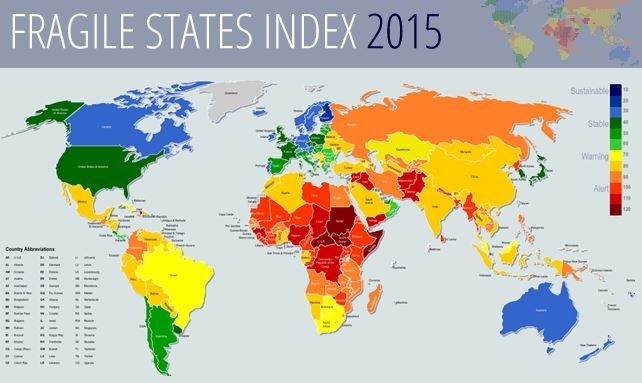
Nigeria is ranked the 15th most failed nation in the world out of a total of 177 countries in a survey by the United States think-tank and an independent research organisation, the Fund for Peace, and the magazine Foreign Policy.
The survey which is the 5th said Nigeria moved upwards three places from 18th position in 2008; and 17th in 2007.
The Index shows that 10 of the most failed nations are in Africa with Somalia emerging as the most failed state. The other African countries include Zimbabwe (2nd), Sudan (3rd), Chad (4th), Democratic Rep of Congo (5th), Central African Republic (8th), Guinea (9th), Ivory Coast (11th), Kenya (14th), and Nigeria (15th).
Advertisement
Norway leads the pack of the best or most sustainable state, followed by Finland (176), Sweden (175), Switzerland (174), and Ireland (173). Ghana emerged the best state in Africa, ranked 124 and classified as moderate state, while USA was 159th and UK 161 on the survey list.
The index’s ranks are based on twelve indicators of state vulnerability – four social, two economic and six political. The indicators are not designed to forecast when states may experience violence or collapse. Instead, they are meant to measure a state’s vulnerability to collapse or conflict.
The Crisis States Research Centre defines a “failed state” as a condition of “state collapse” – i.e., a state that can no longer perform its basic security and development functions and that has no effective control over its territory.
The Index used 12 indicators of state cohesion and performance, compiled through a close examination of more than 30,000 publicly available sources. The survey also ranked 177 states in order from most to least at risk of failure. The 60 most vulnerable states are listed in the rankings.
Advertisement
The list only assesses sovereign states (determined by membership in the United Nations.) Several territories are excluded until their political status and UN membership is ratified in international law.
For example, Taiwan, the Palestinian Territories, Northern Cyprus, Kosovo, and Western Sahara are not included in the list, even though some are recognized as sovereign states by some nations.
Ranking is based on the total scores of the 12 indicators. For each indicator, the ratings are placed on a scale of 0 to 10, with 0 being the lowest intensity (most stable) and 10 being the highest intensity (least stable). The total score is the sum of the 12 indicators and is on a scale of 0-120.
The applied indicators include demographic pressures; massive movement of refugees and internally displaced peoples; legacy of vengeance-seeking group grievance; chronic and sustained human flight; uneven economic development along group lines; and sharp and/or severe economic decline.
Others are criminalisation and/or delegitimisation of the state; progressive deterioration of public services; widespread violation of human rights; security apparatus as ‘state within a state’; rise of factionalised elites; and intervention of other states or external factors.
Advertisement
“It is a sobering time for the world’s most fragile countries—virulent economic crisis, countless natural disasters, and government collapse. This year, we delve deeper than ever into just what went wrong—and who is to blame”, the groups noted.
“Other countries dependent on the import and export of commodities—from Nigeria to Equatorial Guinea to Bangladesh—had a similarly rough go of it last year, suffering what economist Homi Kharas calls a “whiplash effect” as prices spiked sharply and then plummeted. All indications are that 2009 will bring little to no reprieve.”
“The Failed States Index does not provide all the answers, nor does it claim to be able to. But it is a starting point for a discussion about why states fail and what should be done about them—a discussion, sadly, that we might be having even more frequently this year”, the authors noted. All countries in the red (Alert, FSI of 90 or more), orange (Warning, FSI of 60 or more), or yellow (Moderate, FSI of 30 or more) categories display some features that make parts of their societies and institutions vulnerable to failure.
Some in the yellow zone may be failing at a faster rate than those in the more dangerous orange or red zones, and therefore could experience violence sooner. Conversely, some in the red zone, though critical, may exhibit some positive signs of recovery or be deteriorating slowly, giving them time to adopt mitigating strategies.


